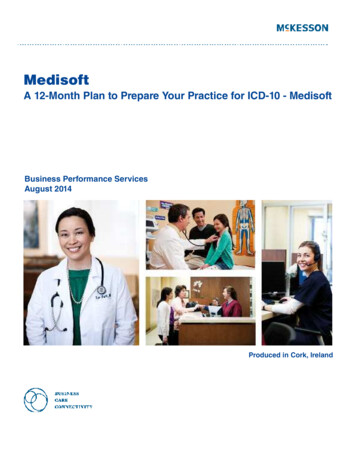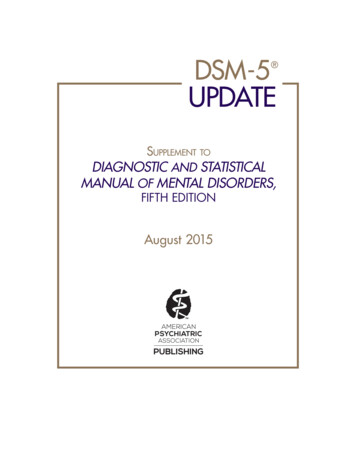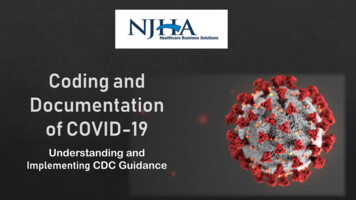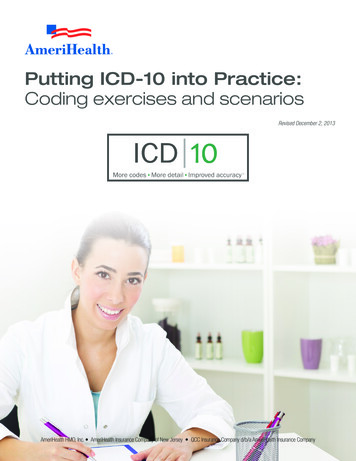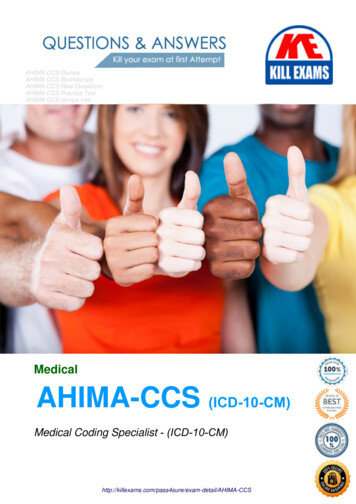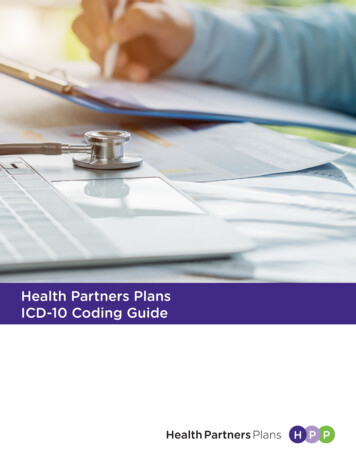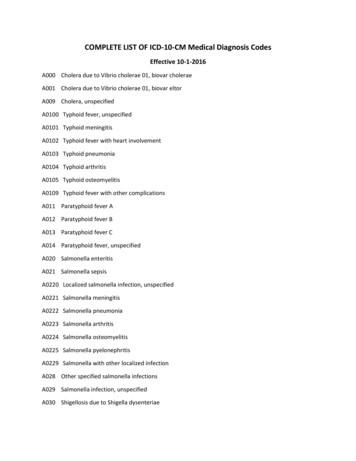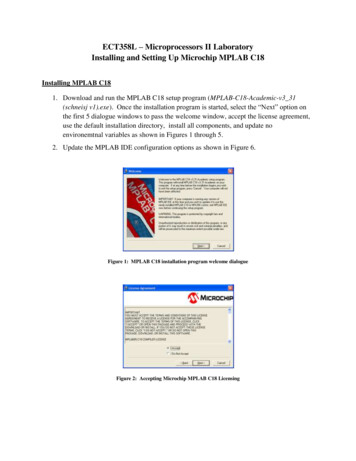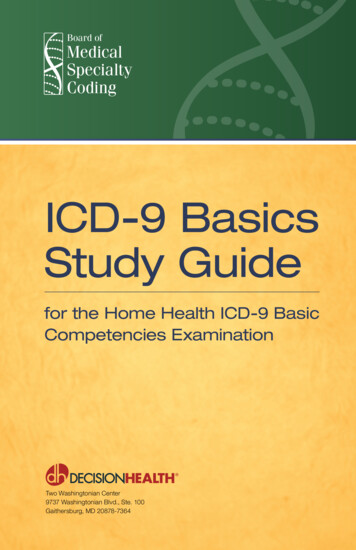
Transcription
Board ofMedicalSpecialtyCodingICD-9 BasicsStudy Guidefor the Home Health ICD-9 BasicCompetencies ExaminationTwo Washingtonian Center9737 Washingtonian Blvd., Ste. 100Gaithersburg, MD 20878-7364
ICD-9 BasicsStudy Guide
IntroductionTo master the basics of ICD-9-CM coding, you must understand thefoundation of coding in the home health environment. There are maincompetencies that coders and clinicians will be tested on. These competencies are listed below, with some main points that each encompasses or that you must understand to code correctly with diagnoses,V and E codes.In general, the core competencies of ICD-9-CM coding involveunderstanding: Guidelines and Conventions Sequencing issues regarding signs and symptoms, acutediseases and V codes, late effects and complications andOASIS item rules V code use Manifestation coding Late effects and complicationsThis short guide highlights the main areas that you must understand– and be able to apply in your ICD-9 Manual – in order to find thecorrect code.ICD-9 Basics Study Guide3
Official Guidelines and ConventionsThe ICD-9-CM Official Guidelines for Coding and Reporting andconventions are specific guidelines and general rules that are applicable to all health care settings, unless otherwise indicated. They provide additional instruction and are based on the coding and sequencing instructions in Volumes 1, 2 and 3 of the ICD-9-CM. Adherenceto these guidelines when assigning diagnosis and procedure codes isrequired under the Health Insurance Portability and AccountabilityAct (HIPAA).There are 16 main guidelines to know and reference when coding.These guidelines cover dozens of pages and are available .htmSome highlights of what a competent basics coder needs to understand: Proper use, and sequence of use of the Alphabetical Indexand Tabular List Locating terms within the Alphabetical Index Specificity in coding: coding to 3, 4 or 5 digits and knowinghow to tell the specificity within the Tabular List Selecting diagnosis codes and V codes Proper signs and symptoms use Coding symptoms integral to a disease Multiple coding for a single condition Acute vs. chronic conditions Combination coding Late effects Ability to code the same diagnosis more than once Admissions or encounters for rehabilitation Pressure ulcer stagingICD-9 Basics Study Guide5
In addition to general coding guidelines, there are guidelines for specific diagnoses and/or conditions in the classification. Unless otherwiseindicated, these guidelines apply to all health care settings. Theseguidelines are specific to individual chapters in the ICD-9-CM manual.Many of them will be covered in the modules on common home carediagnosis coding.Coding guidelines revolve around the ICD-9-CM code set, which iscontained in 3 separate volumes:Volume 1: Tabular List (located after Volume 2 in most manuals)Volume 2: Alphabetical Index to Diseases (located 1st in thefirst manual).Volume 3: Procedures Index and Tabular ListThe Tabular List (Volume 1) contains: 17 Chapters (numerical codes 001 – 999.9) categorized byanatomical site Supplementary Classification: Factor Influencing HealthStatus and Contact with Health Services – V Codes(V01 – V86) Supplementary Classification: External Causes of Injuryand Poisoning – E Codes (E800 – E999)The Alphabetic Index (Volume 2) contains: An alphabetical listing of diseases and reasons for encounters in the health care system Hypertension table Neoplasm table Table of Drugs and Chemicals Index to External Causes if Injury and Poisoning Codes(E codes)6DecisionHealth 2010
The Procedures Index and Tabular List (Volume 3) contains: Index to procedures Tabular list of proceduresCoding conventionsThe conventions are general rules for ICD-9-CM code use, independentof the official coding guidelines. They include abbreviations, punctuation, symbols, typefaces, formatting methods, and rules.The two sources of ICD-9-CM coding conventions are the ICD-9CM Official Guidelines for Coding and Reporting and the ICD-9-CMpublisher-specific formatting conventions. The coding conventions areincorporated within the Alphabetical Index and the Tabular list of anICD-9-CM coding manual as instructional notes.The Coding Conventions coders need to understand are: Format, such as indenting: Abbreviations such as NEC and NOS Punctuation such as [ ], [ ], ( ), : Includes and Excludes Notes and Inclusion Terms Other and Unspecified Codes The meaning of “and,” “with,” “see,” “see also” Phrases such as Use Additional Code, and Code FirstICD-9 Basics Study Guide7
OASIS ItemsWhile there are about 20 OASIS questions that directly affect payment,only five include diagnoses codes. These five are the most importantfor coders to know how to use. M1020, M1022 and M1024, especially,are crucial to understanding how to code and how OASIS interacts withICD-9-CM.M1010: Inpatient DiagnosisList the diagnoses (six slots) for which the patient received treatment inan inpatient facility within 14 days of the start of care assessment. Listonly those diagnoses that required treatment during the inpatient stay.M1016: Diagnoses Requiring Medical or TreatmentRegimen Change Within Past 14 DaysList new diagnoses or diagnoses that have exacerbated over the past 14days. Lists six diagnoses.M1020a: The principal diagnosisThis item identifies the chief reason for providing skilled services. Itrepresents the most acute condition that requires the most intensiveskilled services – the primary or principal reason for home care – thefocus of care. The primary diagnosis may or may not be related to themost recent hospital stay. It is the condition most related to the currenthome health plan of care.The primary diagnosis best reflects the care being provided for the entire episode and may best be described by a V code when the underlying reason for care no longer exists.Consider services, medications, treatments and procedures ordered. Ifmore than one diagnosis is treated concurrently, the primary diagnosisis that which represents the most acute condition and requires the mostintensive skilled service. If two or more diagnoses are being equally8DecisionHealth 2010
monitored, treated, and/or evaluated, the clinician may select whichdiagnosis is sequenced first based on coding guidelines.M1022b-f: The Secondary DiagnosesM1022 identifies all conditions (co-morbidities) that coexisted at thetime the plan of care was established, which developed subsequently,or which affect the treatment or care. Include all pertinent diagnosesrelevant to the care being rendered. The codes/diagnoses assigned inM1022 should be listed in the order that best reflects the seriousnessof the patient’s condition. There are five diagnoses to place in M1022,listed in M1022b-f on the OASIS form.In general, M1022 should include not only conditions actively addressedin the patient’s plan of care, but also any additional co-morbidity (illness/condition/health factor) affecting the patient’s responsiveness totreatment and rehabilitative prognosis.There is no sequencing rule that secondary diagnoses must be codedin the order or severity. There are several things to keep in mind whensequencing the secondary diagnoses, including manifestation codingrules, co-morbidity issues and acute conditions vs. V codes.M1024: The Payment QuestionM1024 is a complicated and technically optional OASIS item intendedto facilitate payment under the Medicare Prospective Payment System (PPS). M1024 is used when a V code is reported as the primarydiagnosis (M1020a) or as a secondary diagnosis (M1022b-f) in place ofa case-mix diagnosis. Using case-mix codes in M1024 helps determinethe PPS case mix. Case-mix codes are those diagnosis codes (and threeV codes: V55.0, V55.5 and V55.6) that CMS has designated as addingpotential points toward additional reimbursement.A case-mix code If an HHA reports a V code in M1020 or M1022 inplace of a case-mix diagnosis, the provider has the option of reporting the case-mix diagnosis in M1024 for payment purposes. ThoughICD-9 Basics Study Guide9
optional, if the case-mix diagnosis is not entered in M1024, the agencywill lose case-mix points that may affect reimbursement.M1024 is broken into two columns, Column 3 and Column 4.Column three is where a case-mix diagnosis is placed. Column 4 iswhere a manifestation of that diagnosis in Column 3, if a manifestation exists and must be coded with the etiology according to codingguidelines, is placed.If a V code is reported in M1020 or M1022 in place of a case-mixdiagnosis, list the diagnosis(es) and ICD-9-CM code(s) in M1024. Inaccordance with OASIS requirements – no V codes, E codes, or surgical procedure codes are allowed in M1024. ICD-9-CM sequencingrequirements must be followed (e.g., mandatory multiple coding).While there are far more intricate rules for appropriate coding inM1024, that rule knowledge is not needed for this exam. This examwill test your basic understanding of the use of M1024.10DecisionHealth 2010
V codesYou should use V codes when: The V code is more specific to the care being rendered thana medical diagnosis The patient has a resolving disease or injury that is not acomplication of care and is admitted for: Therapy services only Surgical, orthopedic or other routine aftercare Circumstances or problems influence a person’s health status but are not in themselves a current illness or injuryHow do you find V codes?Look in the Alphabetical Index for these key terms that are most oftenrelated to home care: AbsenceAdmission forAftercareAttention toEncounter for Fitting ofHistory ofLong-termResistanceStatus (post)V codes and M1024Remember that case-mix codes are placed in M1024 when a V codereplaces a diagnosis case-mix code in M1020 or M1022b-f. If thecase-mix code is the underlying diagnosis for why the case-mix code isbeing used, it can go in M1024 Column 3. If it has a manifestation, themanifestation can go in M1024 Column 4.ICD-9 Basics Study Guide11
V codes account for: Occasions when a patient with a resolving disease or injuryor a chronic condition encounters the health care system forspecific aftercare or treatment When circumstances or problems influence a person’s healthstatus but are not in themselves a current illness or injury Reporting reasons for encounters with health care providers.Some V codes can be designated as primary codes, only to be coded inM1020a; others can be assigned only as secondary (M1022b-f), someas both. Coders must pay attention to the designations in the codingmanual indicating whether a V code can be primary only, secondaryonly, either, or unspecified.12DecisionHealth 2010
SequencingThe first step in successful sequencing is a great assessment anddetermining the relevant diagnoses and procedures is the first step toaccurate coding. To begin your coding with the primary diagnosis, youmust choose the diagnosis that is the chief reason for providing skilledservices in home care.When determining the primary diagnosis, ask yourself What is the focus of care? Which of the other diagnoses will impact the healing or recovery of the primary diagnosis the most? and several other questions.The primary focus of care is placed in M1020a. Secondary diagnosesgo in M1022b-f. The sequencing rules surrounding M1022 are fuzzierthan with M1022a.The secret to sequencing is prioritizing the care. All pertinent diagnosesmust be listed on the Plan of Care in the order of their seriousness tojustify the services being rendered.ICD-9 Basics Study Guide13
Manifestation codingManifestations are characteristics, signs or symptoms of an illness.When one disease or condition causes another disease or condition, theone that caused it is the etiology and the resulting second condition isthe manifestation.According to the coding guidelines, manifestation codes must be preceded by the code for the underlying condition or etiology. For example, the code for diabetic gangrene, gangrene caused by diabetes wheregangrene is the manifestation and diabetes the etiology, would be listed1. Diabetes (the etiology) 250.7x2. Gangrene (the manifestation) 785.4With manifestation coding, the usual rule of the focus of care being sequenced first is broken. If a manifestation is the focus of care, it is stillsequenced second, behind its etiology. This guideline supersedes usualguidelines on first-listed diagnoses.14DecisionHealth 2010
ComplicationsA complication is a problem that arises complicating the healing process of the initial illness, injury or medical/surgical procedure. There isno time limit as to when a complication may occur.Complications are generally found in categories 996-999. Look in the Alphabetical Index under “Complications.” Make sure you verify the codein the Tabular List and follow the directions to use additional codes.Do not use a V code with a complication unless instructed by the codebook to do so!Late effectsA late effect is the residual effect (condition produced) after the acutephase of an illness or injury has terminated. There is no time limit onwhen a late effect code can be used. The residual may be apparent earlysuch as an infection of the central nervous system, or it may occurmonths or years later, such as that due to a previous injury.When coding a late effect, reference the word “late” in the AlphabeticalIndex. Coding of late effects generally requires two codes sequencedas follows: First – the condition or nature of the late effect (residual) Second – the cause of the late effect For example, gait abnormality as a late effect of hip fracture 781.2 Abnormality of gait 905.3 Late effect of hip fractureException to the rule: If the late effect code includes the manifestation,or late effects of CVA. Many codes in Category 438 are combinationcodes. In that case, use one code to describe the late effect: If a patientdevelops aphasia from a CVA, code 438.11, Late effect of CVA, Aphasia.ICD-9 Basics Study Guide15
Symptom codingSymptom codes, found in Chapter 16 of Volume 1 – Signs, Symptomsand Ill-Defined Conditions (780-799), describe patient problems, notdiseases. While Chapter 16 codes can be assigned as the principaldiagnosis in M1020, it is required under the coding guidelines to codea definitive diagnosis, if determined. Home health cannot code onsuspected diagnoses or assumed diagnoses. Symptoms should be codedin that situation.The acute or chronic condition underlying a symptom, if determined,should always be coded for coding accuracy and risk adjustment. Codeonly “confirmed” diagnoses. Do not code “rule out,” “suspected” or“probable” diagnoses. If there is no definitive diagnosis, coding thesymptom may be the only option.16DecisionHealth 2010
E codesCoding guidelines state to assign an E code for the initial encounterof an injury, poisoning, or adverse effect due to an external cause.However, home health agencies are not prohibited from using them forsubsequent treatment. The use of E codes in home care may be helpfulin medical review, especially in reporting how and where an injury ortrauma wound occurred.E codes are required to identify the causative substance for an adverseeffect of a drug correctly prescribed and properly administered. In thiscase, the adverse effect is coded first, and is followed by the appropriateE code from E930-E949.ICD-9 Basics Study Guide17
Medical Specialty Coding Board of ICD-9 Basics Study Guide for the Home Health ICD-9 Basic Competencies Examination Two Washingtonian Center 9737 Washingtonian Blvd., Ste. 100 Gai
